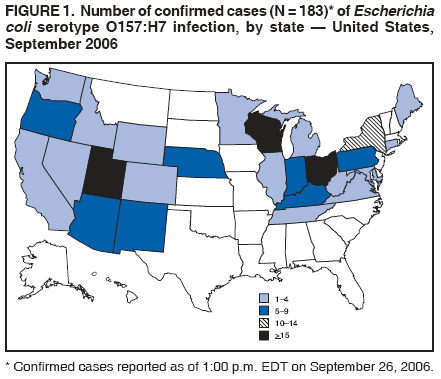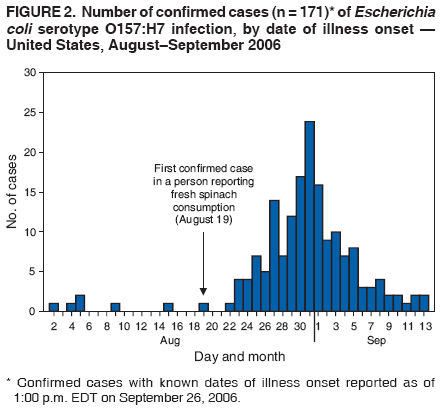 |
|
|
|
|
|
|
| ||||||||||
|
|
|
|
|
|
|
||||
| ||||||||||
|
|
|
|
|
Persons using assistive technology might not be able to fully access information in this file. For assistance, please send e-mail to: mmwrq@cdc.gov. Type 508 Accommodation and the title of the report in the subject line of e-mail. Ongoing Multistate Outbreak of Escherichia coli serotype O157:H7 Infections Associated with Consumption of Fresh Spinach --- United States, September 2006On September 13, 2006, CDC officials were alerted by epidemiologists in Wisconsin and Oregon that fresh spinach was the suspected source of small clusters of Escherichia coli serotype O157:H7 infections in those states. On the same day, New Mexico epidemiologists contacted Wisconsin and Oregon epidemiologists about a cluster of E. coli O157:H7 infections in New Mexico associated with fresh spinach consumption. Wisconsin public health officials had first reported a cluster of E. coli O157:H7 infections to CDC on September 8. On September 12, CDC PulseNet had confirmed that the E. coli O157:H7 strains from infected patients in Wisconsin had matching pulsed-field gel electrophoresis (PFGE) patterns and identified the same pattern in patient isolates from other states. This report describes the joint investigation and outbreak-control measures undertaken by state public health officials, CDC, and the Food and Drug Administration (FDA). This investigation and additional case finding are ongoing. As of September 26, a total of 183 persons infected with the outbreak strain of E. coli O157:H7 had been reported to CDC from 26 states (Figure 1). Among the ill persons, 95 (52%) were hospitalized, 29 (16%) had hemolytic uremic syndrome (HUS), and one person died. The deaths of two other patients possibly related to this outbreak are under investigation. Eighty-five percent of patients reported illness onset from August 19 to September 5 (Figure 2). Fresh spinach was identified as the source of the outbreak. One hundred twenty-three of 130 patients (95%) reported consuming uncooked fresh spinach during the 10 days before illness onset. In addition, E. coli O157:H7 with a PFGE pattern matching the outbreak strain has been isolated from three open packages of fresh spinach consumed by patients (one from New Mexico, one from Utah, and one from Pennsylvania). On September 14, FDA advised consumers by press release and press conference to not eat bagged fresh spinach. On September 15, a California company that bags spinach under several brand names announced a voluntary recall of all fresh spinach-containing products. On September 16, FDA expanded its warning and advised consumers to not eat fresh spinach or fresh spinach-containing products. On September 21, FDA informed consumers that only spinach grown in three California counties (Monterey, San Benito, and Santa Clara) was implicated in the outbreak. A confirmed case is defined as a culture-confirmed E. coli O157:H7 infection in a person residing in the United States, with illness onset from August 1 to the present (or, if date of onset is unknown, E. coli O157:H7 isolated from August 15 to the present) and a PFGE pattern identified by the XbaI restriction enzyme that matches the pattern of the outbreak strain. August 1 was selected as the earliest illness onset date in the case definition to ensure that the earliest cases in the outbreak were identified and investigated. However, the first six confirmed cases (with illness onsets during August 2--15) were in persons who did not report fresh spinach consumption during the week before illness onset. The first date that illness onset was reported by a person who recently consumed fresh spinach was August 19. Infections with this outbreak strain of E. coli O157:H7 (one of 3,520 unique E. coli O157:H7 strains reported to CDC PulseNet since 1996) have been reported sporadically to CDC PulseNet since 2003 (an average of 21 cases per year during 2003--2005). This finding suggests the occasional presence of this strain in the environment and food supply; however, it has not been associated with a recognized outbreak in the past. The time from illness onset to confirmation that a case of E. coli O157:H7 is part of an outbreak is typically 2--3 weeks, including the time required for an infected person to seek medical care and for health-care providers and public health officials to obtain a culture, transfer the bacterial culture to a public health laboratory, perform PFGE testing, and submit the PFGE pattern into the national database at CDC. In this outbreak, the average time from illness onset to PFGE pattern submission to the national database at CDC has been 15 days; additional information is available at http://www.cdc.gov/foodborne/ecolispinach/reportingtimeline.htm. Parallel laboratory and epidemiologic investigations were crucial in identifying the source of this outbreak. Timely PFGE testing by state public health laboratories, PFGE pattern submission by states to CDC PulseNet, and analysis of PFGE patterns in the CDC PulseNet national database resulted in rapid detection of the outbreak. Concurrent collection of case exposure information by epidemiologists in affected states and sharing of exposure information among states and CDC led to rapid identification of the suspected food source and public health action. Continued rapid diagnosis, culture, PFGE analysis, and reporting to CDC of E. coli O157:H7 infections are needed to aid this investigation and to detect and investigate E. coli O157:H7 outbreaks in the future. New information regarding the current E. coli O157:H7 outbreak will be available regularly. The most current information is available online at http://www.cdc.gov/foodborne/ecolispinach; this website contains information updated daily on the number of cases and affected states in addition to general information regarding E. coli O157:H7, resources for clinicians, and activities by CDC and other agencies. The FDA website, at http://www.fda.gov/oc/opacom/hottopics/spinach. html, contains advice for consumers on the current outbreak and food-safety guidelines. CDC's public inquiry line (telephone, 1-800-CDC-INFO) also can provide information on the current outbreak to both the public and health-care workers. Information about the current E. coli O157:H7 outbreak is also available by RSS (Really Simple Syndication); a subscription to the E. coli O157:H7 outbreak RSS information can be obtained at http://www.bt.cdc.gov/rss. Reported by: State and local health departments. E. coli O157:H7 investigation team, CDC. Figure 1  Return to top. Figure 2  Return to top.
Disclaimer All MMWR HTML versions of articles are electronic conversions from ASCII text into HTML. This conversion may have resulted in character translation or format errors in the HTML version. Users should not rely on this HTML document, but are referred to the electronic PDF version and/or the original MMWR paper copy for the official text, figures, and tables. An original paper copy of this issue can be obtained from the Superintendent of Documents, U.S. Government Printing Office (GPO), Washington, DC 20402-9371; telephone: (202) 512-1800. Contact GPO for current prices. **Questions or messages regarding errors in formatting should be addressed to mmwrq@cdc.gov.Date last reviewed: 9/26/2006 |
|||||||||
|